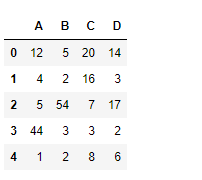Python | Pandas dataframe.mask()
Last Updated :
19 Nov, 2018
Python is a great language for doing data analysis, primarily because of the fantastic ecosystem of data-centric python packages. Pandas is one of those packages and makes importing and analyzing data much easier.
Pandas dataframe.mask() function return an object of same shape as self and whose corresponding entries are from self where cond is False and otherwise are from other object. The other object could be a scalar, series, dataframe or could be a callable. The mask method is an application of the if-then idiom. For each element in the calling DataFrame, if cond is False the element is used; otherwise the corresponding element from the DataFrame other is used.
Syntax: DataFrame.mask(cond, other=nan, inplace=False, axis=None, level=None, errors=’raise’, try_cast=False, raise_on_error=None)
Parameters :
cond : Where cond is False, keep the original value. Where True, replace with corresponding value from other. If cond is callable, it is computed on the NDFrame and should return boolean NDFrame or array. The callable must not change input NDFrame (though pandas doesn’t check it).
other : Entries where cond is True are replaced with corresponding value from other. If other is callable, it is computed on the NDFrame and should return scalar or NDFrame. The callable must not change input NDFrame (though pandas doesn’t check it).
inplace : Whether to perform the operation in place on the data
axis : alignment axis if needed, default None
level : alignment level if needed, default None
errors : str, {‘raise’, ‘ignore’}, default ‘raise’
raise allow exceptions to be raised and ignore suppress exceptions. On error return original object. Note that currently this parameter won’t affect the results and will always coerce to a suitable dtype.
try_cast : try to cast the result back to the input type (if possible),
Returns : wh : same type as caller
Example #1: Use mask() function to replace all the values in the dataframe which are greater than 10 with -25
import pandas as pd
df = pd.DataFrame({"A":[12, 4, 5, 44, 1],
"B":[5, 2, 54, 3, 2],
"C":[20, 16, 7, 3, 8],
"D":[14, 3, 17, 2, 6]})
df
|

Let’s use the dataframe.mask() function to replace all the values greater than 10 with -25
Output :

Example #2: Use mask() function with a callable. Replace all the Na value with 1000.
import pandas as pd
df = pd.DataFrame({"A":[12, 4, 5, None, 1],
"B":[7, 2, 54, 3, None],
"C":[20, 16, 11, 3, 8],
"D":[14, 3, None, 2, 6]})
df.mask(df.isna(), 1000))
|
Output :

Share your thoughts in the comments
Please Login to comment...